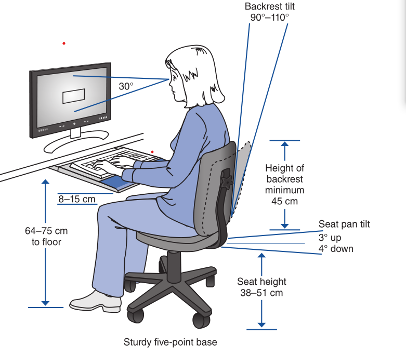Today we explore the most common conditions seen in people who work from home offices, some of which include poor posture, wrist pain, neck ache, back ache and more. Learn how to spot these injuries, and go through a lot of tips and exercises to prevent them.
Sitting for a lengthy period of time is unhealthy. It leads to aches and pains in various parts of the body. If you add a sedentary lifestyle to the mix, it creates a risk for developing medical conditions like cardiovascular disorders, diabetes, obesity, and more. Further, standing for an extended period is also detrimental since it can lead to varicose veins and leg fatigue.
With the increase in use of technology at home and at workplace, many people and employers are embracing ergonomics into their workspace setup to prevent injuries. We see the growing use of adjustable workstations like sit-to-stand desks and chairs, ergonomic mice and keyboards, monitor reflectors and screen protectors, and flexible desk arrangement for phones, tablets, and document holders. Sadly, without adequate guidance on how to fine tune your setup, you can still hurt yourself and need treatment.
Common Work from Home Problems & Signs
The most common problems affect muscles, bones, joints, ligaments, nerves, blood vessels or soft tissue. In physical therapy, we group these into Musculoskeletal Injuries (MSI). Some common reasons for them to happen are:
a) Repetitive movements—like frequent bending of your wrist forward or backward when using mouse or keyboard causes compression of nerves as they pass through wrist joints (can lead to carpal tunnel syndrome). Common symptoms are tingling / numbness in hands and difficulty in grasping objects.
b) Poor posture—bending your neck forward and sitting in a hunched position causes muscle fatigue. When continued for longer duration, it leads to tightness in one group of muscles and weakness in the opposite group of muscles. This muscle imbalance produces pain, spasm, and discomfort in your neck.
c) Static position—if you are sitting in one position for too long during work or are driving, muscles switch on to hold the position. When you continue this for a few hours, muscles tire out leading to strain from overworking.
We recommend you always listen to your body. It will signal to you, be it sudden or gradual, when something is not right. Most common discomforts include upper back and neck pain, shoulder and elbow pain, wrist and hand pain, low back pain and lower leg pain. Pay special attention to cramps, aches, and stiffness. You may feel tingling or numbness in the area because of irritation of your nerves. Heaviness or pressure in an area implies issues related to blood vessels.
Vision
The next frequent problem I treat concerns vision. Our increasing digital life (at work and then at home) makes it hard to give our eyes some rest. Focusing at a screen for an extended period puts stress on your eyes as does moving your eyes constantly. The continuous use of your eye muscles tires them out. This can lead to headaches, eye fatigue, blurry vision, and dry eyes.
Any stress, physical or mental, will affect your ability to function and maintain a high quality of life. To keep these in check, I recommend few best practices and exercises:
Work from home setup

A temporary / makeshift set up is good for few hours of work. Anything extended (like days or months) requires a dedicated workspace. There are many good ergonomic guidelines online. We have linked some of them at the bottom. When following any of these guidelines, focus on the comfort level of your body and any stress it contains. You don’t have to solve all your stress points from the very first day (our bodies are resilient). Aim to address them all eventually, and have a comfortable workspace as you can afford.
Posture tips:
Sit or stand with your head upright, not tilting forward or backward. Your spine should be upright, keeping the natural curves of your spines. Relax your shoulders. Keep forearms horizontal. Be hip-width apart when standing with your feet firmly planted on the ground.
Adjustments
Following adjustments to your workstation will avoid any repetitive activities, awkward posture, and static positions.
- Upper back and neck pain: Review chair, monitor, or document positions. When font-size makes a big difference, see your eye doctor.
- Shoulder and elbow pain: Revisit the height of keyboard, mouse, or reach of common objects.
- Wrist and hand pain: Adjust your angle of wrist and hand when writing, typing, or using a mouse.
- Lower back pain: Tweak your chair. Use pillows or towels for manual adjustments. Take frequent breaks.
- Lower leg pain: Adjust height of your chair, seat angle, foot position and leg space. Make sure you can take frequent breaks and move.
- Headaches or vision problems: Check your lighting levels and viewing distance. Reach out to an eye doctor.
Frequent Position Changes
Human body loves to move and hates staying still for long. Recent guidelines suggest 2 minutes of movement for every 30 minutes of sitting. I like to call them micro-pauses. This could be taking a coffee break, walking to a colleague, or doing exercises. If you are using a sit to stand desk, alternate sitting and standing every 30 minutes. It is okay to count in the time to adjust the height and position of your equipment.
If you are among those who like to stand for an extended period, you are at higher risk of developing varicose veins. Research studies have proven that standing is more tiring than sitting ~ 20%. Standing also puts more strain on circulatory systems, legs, and feet. Using anti-fatigue mats and footwear help. Switching between sitting, standing, and moving is more effective. Always remember “move little and more often.”
Great exercises to do at home
Stretching Exercises
Corner Stretch
Stand in an upright position facing a corner. Place your forearms flat on each side with your elbow bent to 90 degrees. Slowly lean forward. You can also take a step forward if needed. You should feel a gentle stretch in front of your chest. Hold. Relax and repeat.
Spine Stretch
Standing in an upright position holding a sturdy chair or desk. Hinge at your hips keeps lower leg straight as much as possible. Gently lower your trunk towards the ground until you feel a stretch in your spine and legs. Hold. Relax and repeat.
Mobility Exercises
Prayer position
Begin in a standing position with your palms together in a prayer position. Gently push your hands together and gradually lower them down towards your tummy until you feel a stretch in your wrists. Hold. Relax and repeat.
Trunk Extension
Begin in standing upright position with hands resting on your hips. Slowly arch your trunk backwards, keeping your knee straight. Relax and repeat.
Strengthening Exercises
Triceps dips
Begin in sitting upright position in chair, or couch. Move your body forward off the chair while keeping your arms on the edge. Slowly lower yourself toward the ground, push back up. Relax and repeat.
Standing lunges
Begin standing upright with your hands resting on your hips and keeping your feet shoulder width apart. Slowly take a step forward and lower your body toward the ground into a lunge position. Gently return to starting position. Relax and repeat.
Mental Health
Try to organize your day to pace yourself, decrease stress, and take multiple micro-pauses throughout the day. This will allow you to change your posture, rest your muscles, and reset your thoughts. Striving to achieve work life balance when possible and staying active will help improve your physical and mental well-being.
Managing pain and When to consult Physio
There are many considerations when working remote: changing equipment, workstation, and daily practices. First, try the techniques listed above to prevent discomfort. If you are still suffering from aches or pain, try minimizing activities that causing pain. This will decrease strain on soft tissues, allowing some time to heal. For muscle pain, application of heat instead of cold will be more beneficial to increase blood flow. Exercises help to promote circulation, decrease muscle tension, and relieve joint stiffness. Consult your physiotherapist if you are unsure about which exercises to do and when common practices are not helping. We are skilled practitioners with extensive education in human movement and will design a program for your needs. We also give feedback ergonomic setups. To see a physio from home, get in touch on how I can help.
Further Readings
- Work related musculoskeletal disorder and ergonomics – Centers for Disease Control and Prevention https://www.cdc.gov/workplacehealthpromotion/health-strategies/musculoskeletal-disorders/index.html
- Work related musculoskeletal disorders – Canadian Centre for Occupational Health and Safety https://www.ccohs.ca/oshanswers/diseases/rmirsi.html
- How to make your computer workstation fit you – WorkSafe BC https://www.worksafebc.com/en/resources/health-safety/books-guides/how-to-make-your-computer-workstation-fit-you?lang=en
- A sedentary office: Growing case for change towards better health and productivity https://bjsm.bmj.com/content/49/21/1357
